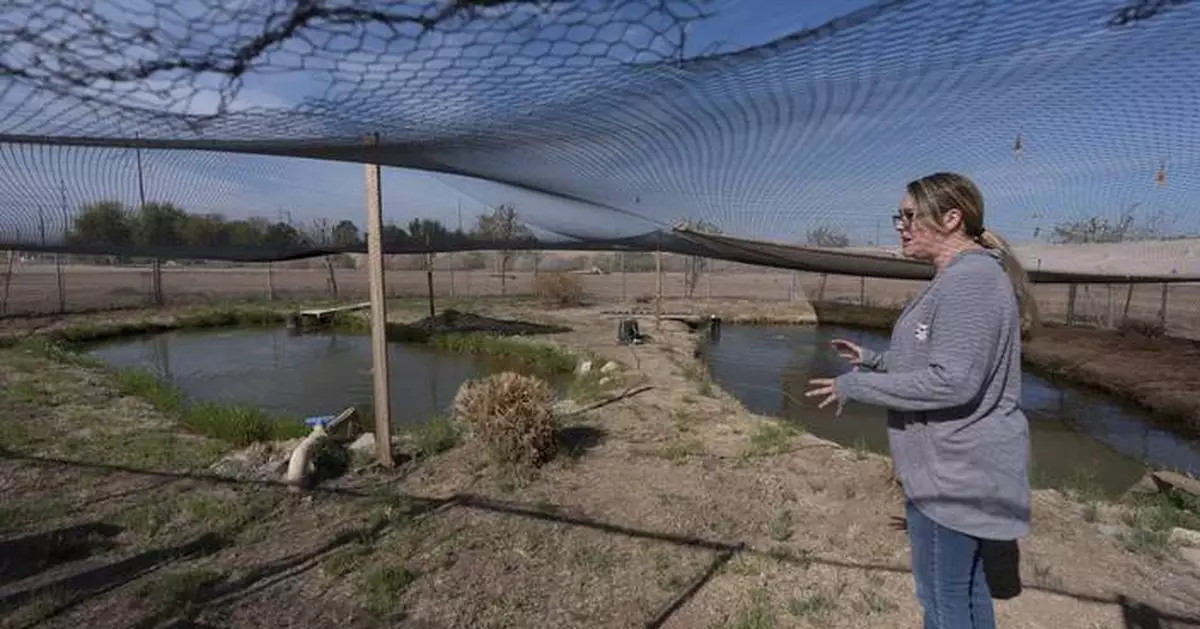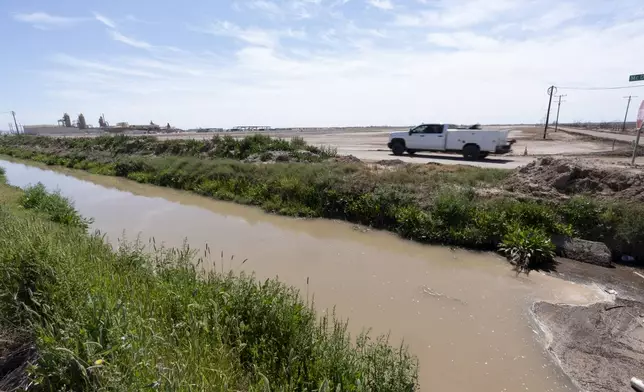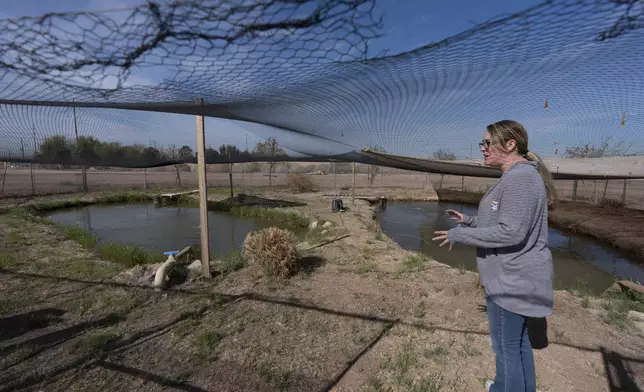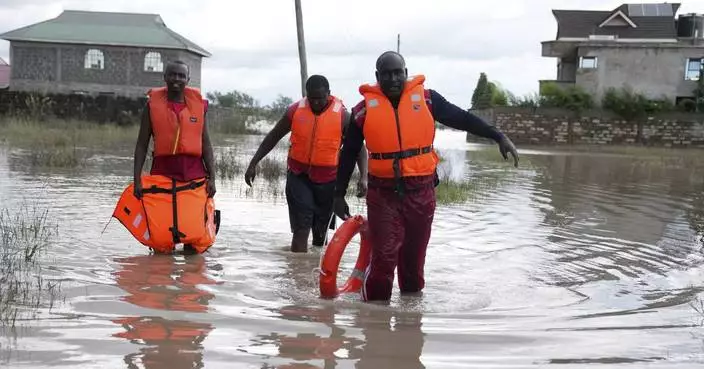Southern California's Imperial Irrigation District, which supplies water to farmers who grow most of the nation's winter vegetables, planned to start a conservation program in April to scale back what it draws from the critical Colorado River.
But a tiny, tough fish got in the way.
Click to Gallery
Jessica Humes, Environmental Project Manager for the Imperial Irrigation District, looks over a pond refuge for the desert pupfish, Friday, March 22, 2024, in Imperial, Calif. The Imperial Irrigation District created a plan to scale back draws from the Colorado River in a bid to preserve the waterway following years of drought. But a tiny, tough fish got in the way. The proposal to pay farmers to temporarily stop watering forage crops this summer has environmentalists concerned that irrigation drains could dry up, threatening the fish, she said. (AP Photo/Gregory Bull)
Southern California's Imperial Irrigation District, which supplies water to farmers who grow most of the nation's winter vegetables, planned to start a conservation program in April to scale back what it draws from the critical Colorado River.
The 1,450-mile (2,334-kilometer) river provides water to 40 million people in seven U.S. states, parts of Mexico and more than two dozen Native American tribes. It's long been over-tapped, a problem aggravated by recent years of prolonged drought. The Western states are negotiating a new long-term use plan meant to stabilize the river.
Now the district, the biggest user of Colorado River water with more than 3,000 miles (4,828 kilometers) of canals and drains, is in talks with state and federal officials on how it can proceed while setting up a monitoring program to ensure the fish isn’t further threatened, Asbury said.
“A lot of them do live in these really bizarre drains, these agricultural drains,” she said. “These fish are incredibly tough — they basically just try to find a space where they can carry on their lives.”
“This is conservation,” Danoff-Burg said. “There are always wicked problems, as they say, all these conflicting things that are working against each other, and you try to muddle through as best you can.”
Jessica Humes, Environmental Project Manager for the Imperial Irrigation District, looks over a pond refuge for the desert pupfish, Friday, March 22, 2024, in Imperial, Calif. The Imperial Irrigation District created a plan to scale back draws from the Colorado River in a bid to preserve the waterway following years of drought. But a tiny, tough fish got in the way. The proposal to pay farmers to temporarily stop watering forage crops this summer has environmentalists concerned that irrigation drains could dry up, threatening the fish, she said. (AP Photo/Gregory Bull)
Now, those plans won't start until at least June so water and wildlife officials can devise a way to ensure the endangered desert pupfish and other species are protected, said Jamie Asbury, the irrigation district’s general manager. The proposal to pay farmers to temporarily stop watering feed crops such as alfalfa this summer has environmentalists concerned that irrigation drains could dry up, threatening the fish that measures the length of an ATM card.
“Drains are created for farmers to be able to convey irrigation runoff, and the pupfish decided it was a good place to live,” Asbury said.
Protecting the desert pupfish, listed as endangered since 1986, has been one of many vexing problems facing the Colorado River and the people and species that rely on it.

Vegetation grows along a water-filled irrigation drain leading towards the Salton Sea Friday, March 22, 2024, near Calipatria, Calif. The Imperial Irrigation District created a plan to scale back draws from the Colorado River in a bid to preserve the waterway following years of drought. But a tiny, tough fish got in the way. The proposal to pay farmers to temporarily stop watering forage crops this summer has environmentalists concerned that irrigation drains could dry up, threatening the fish, she said. (AP Photo/Gregory Bull)
The 1,450-mile (2,334-kilometer) river provides water to 40 million people in seven U.S. states, parts of Mexico and more than two dozen Native American tribes. It's long been over-tapped, a problem aggravated by recent years of prolonged drought. The Western states are negotiating a new long-term use plan meant to stabilize the river.
Last year, Arizona, Nevada and California offered to cut back on their use of Colorado River water in exchange for money from the federal government to avoid forced cuts. California, which gets the most water of all the states based on a century-old water rights priority system, agreed to give up 1.6 million acre-feet of water through 2026, with more than half coming from the Imperial Irrigation District. An acre-foot serves about two to three U.S. households per year.
The Imperial district envisioned a summer idling program in which farmers could turn off water for 60 days for feed crops since yields already are down at that time of year and growing requires much more water. But environmental officials worried that limiting the flow of water through irrigation drains could harm the desert pupfish. They also raised concerns about the impact on migratory birds that frequent the Salton Sea, Asbury said.

Jessica Humes, Environmental Project Manager for the Imperial Irrigation District, looks into a pond refuge for the desert pupfish, Friday, March 22, 2024, in Imperial, Calif. The Imperial Irrigation District created a plan to scale back draws from the Colorado River in a bid to preserve the waterway following years of drought. But a tiny, tough fish got in the way. The proposal to pay farmers to temporarily stop watering forage crops this summer has environmentalists concerned that irrigation drains could dry up, threatening the fish, she said. (AP Photo/Gregory Bull)
Now the district, the biggest user of Colorado River water with more than 3,000 miles (4,828 kilometers) of canals and drains, is in talks with state and federal officials on how it can proceed while setting up a monitoring program to ensure the fish isn’t further threatened, Asbury said.
The curious fish -- the males turn blue during breeding season while females are tan or olive -- was once plentiful. But with the introduction of invasive species in the Colorado River, its numbers dwindled, according to California’s Department of Fish and Wildlife. The fish feeds on invertebrates and snails and can handle an extreme range of water temperatures and both fresh and saltwater.
Today, it lives in a few areas in California, Arizona and Mexico, including the Imperial Irrigation District’s drains, which funnel water runoff from farms in California's Imperial Valley into the saline Salton Sea, a drying lake with no outlet that's a stopover point for migratory birds.
Often, the district's drains have more fresh water than the Salton Sea, so the fish seek out those spaces, said Ileene Anderson, senior scientist with the Center for Biological Diversity. The fish has proven remarkably resilient and can survive in water with low oxygen levels, high salinity and temperatures of more than 100 degrees Fahrenheit (37.7 degrees Celsius).

Jessica Humes, Environmental Project Manager for the Imperial Irrigation District, looks over a pond refuge for the desert pupfish, Friday, March 22, 2024, in Imperial, Calif. The Imperial Irrigation District created a plan to scale back draws from the Colorado River in a bid to preserve the waterway following years of drought. But a tiny, tough fish got in the way. The proposal to pay farmers to temporarily stop watering forage crops this summer has environmentalists concerned that irrigation drains could dry up, threatening the fish, she said. (AP Photo/Gregory Bull)
“A lot of them do live in these really bizarre drains, these agricultural drains,” she said. “These fish are incredibly tough — they basically just try to find a space where they can carry on their lives.”
The desert pupfish is a key part of the ecosystem in the Salton Sea, feeding on biting flies and serving as a food source for birds, said James Danoff-Burg, vice president of conservation at the Palm Desert-based Living Desert Zoo and Gardens, which works on desert conservation. In the summer, creeks that flow into the Salton Sea can dry out so much the fish risk getting stranded, so they are moved to special ponds as an insurance population, he said.
California’s Department of Fish and Wildlife declined to discuss the water conservation plan. The department said in an emailed statement that officials support water use reductions on the Colorado River and will work with other agencies to “find solutions that proactively minimize and mitigate any potential impacts to the great work underway.”
The Bureau of Reclamation, which operates major dams in the Colorado River system, did not immediately comment.
Environmentalists have long said that while many species depend on the Colorado River, decisions about how to use its water typically focus on human needs, not wildlife.
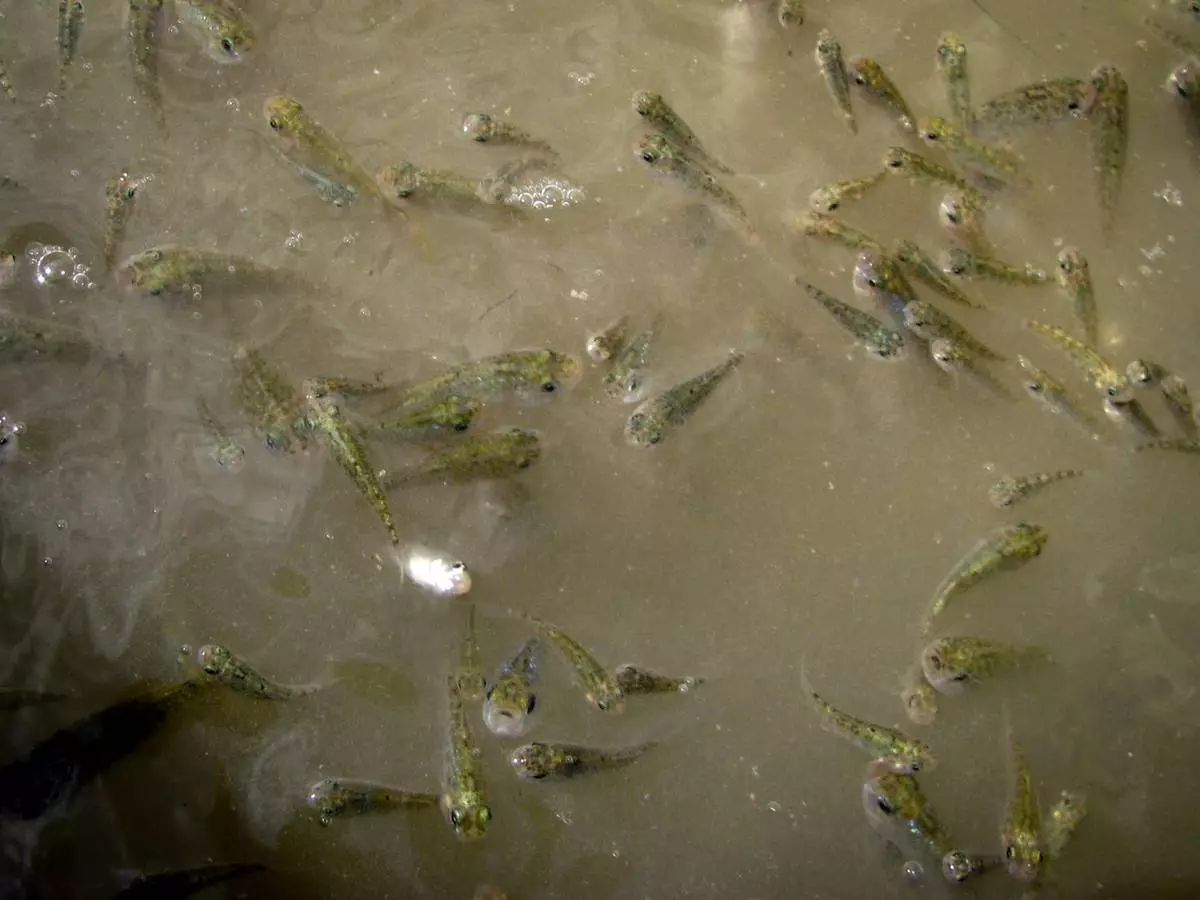
In this 2010 handout image, desert pupfish are seen in a refuge pond in Imperial, Calif. The Imperial Irrigation District created a plan to scale back draws from the Colorado River in a bid to preserve the waterway following years of drought. But a tiny, tough fish got in the way. The proposal to pay farmers to temporarily stop watering forage crops this summer has environmentalists concerned that irrigation drains could dry up, threatening the fish, she said. (Jessica Humes/Imperial Irrigation District via AP)
“This is conservation,” Danoff-Burg said. “There are always wicked problems, as they say, all these conflicting things that are working against each other, and you try to muddle through as best you can.”
This story’s headline has been updated to correct that it is California’s Colorado River conservation plan, not California River conservation plan.

Vegetation grows along a water-filled irrigation drain leading towards the Salton Sea Friday, March 22, 2024, near Calipatria, Calif. The Imperial Irrigation District created a plan to scale back draws from the Colorado River in a bid to preserve the waterway following years of drought. But a tiny, tough fish got in the way. The proposal to pay farmers to temporarily stop watering forage crops this summer has environmentalists concerned that irrigation drains could dry up, threatening the fish, she said. (AP Photo/Gregory Bull)

Jessica Humes, Environmental Project Manager for the Imperial Irrigation District, looks over a pond refuge for the desert pupfish, Friday, March 22, 2024, in Imperial, Calif. The Imperial Irrigation District created a plan to scale back draws from the Colorado River in a bid to preserve the waterway following years of drought. But a tiny, tough fish got in the way. The proposal to pay farmers to temporarily stop watering forage crops this summer has environmentalists concerned that irrigation drains could dry up, threatening the fish, she said. (AP Photo/Gregory Bull)
HARARE, Zimbabwe (AP) — From ancient fertilizer methods in Zimbabwe to new greenhouse technology in Somalia, farmers across the heavily agriculture-reliant African continent are looking to the past and future to respond to climate change.
Africa, with the world's youngest population, faces the worst effects of a warming planet while contributing the least to the problem. Farmers are scrambling to make sure the booming population is fed.
With over 60% of the world’s uncultivated land, Africa should be able to feed itself, some experts say. And yet three in four people across the continent cannot afford a healthy diet, according to a report last year by the African Union and United Nations agencies. Reasons include conflict and lack of investment.
In Zimbabwe, where the El Nino phenomenon has worsened a drought, small-scale farmer James Tshuma has lost hope of harvesting anything from his fields. It's a familiar story in much of the country, where the government has declared a $2 billion state of emergency and millions of people face hunger.
But a patch of green vegetables is thriving in a small garden the 65-year-old Tshuma is keeping alive with homemade organic manure and fertilizer. Previously discarded items have again become priceless.
“This is how our fathers and forefathers used to feed the earth and themselves before the introduction of chemicals and inorganic fertilizers,” Tshuma said.
He applies livestock droppings, grass, plant residue, remains of small animals, tree leaves and bark, food scraps and other biodegradable items like paper. Even the bones of animals that are dying in increasing numbers due to the drought are burned before being crushed into ash for their calcium.
Climate change is compounding much of sub-Saharan Africa’s longstanding problem of poor soil fertility, said Wonder Ngezimana, an associate professor of crop science at Zimbabwe’s Marondera University of Agricultural Sciences and Technology.
“The combination is forcing people to re-look at how things were done in the past like nutrient recycling, but also blending these with modern methods," said Ngezimana, whose institution is researching the combination of traditional practices with new technologies.
Apart from being rich in nitrogen, organic fertilizers help increase the soil’s carbon and ability to retain moisture, Ngezimana said. “Even if a farmer puts synthetic fertilizer into the soil, they are likely to suffer the consequences of poor moisture as long as there is a drought,” he said.
Other moves to traditional practices are under way. Drought-resistant millets, sorghum and legumes, staples until the early 20th century when they were overtaken by exotic white corn, have been taking up more land space in recent years.
Leaves of drought-resistant plants that were once a regular dish before being cast off as weeds are returning to dinner tables. They even appear on elite supermarket shelves and are served at classy restaurants, as are millet and sorghum.
This could create markets for the crops even beyond drought years, Ngezimana said.
In conflict-prone Somalia in East Africa, greenhouses are changing the way some people live, with shoppers filling up carts with locally produced vegetables and traditionally nomadic pastoralists under pressure to settle down and grow crops.
“They are organic, fresh and healthy,” shopper Sucdi Hassan said in the capital, Mogadishu. “Knowing that they come from our local farms makes us feel secure."
Her new shopping experience is a sign of relative calm after three decades of conflict and the climate shocks of drought and flooding.
Urban customers are now assured of year-round supplies, with more than 250 greenhouses dotted across Mogadishu and its outskirts producing fruit and vegetables. It is a huge leap.
“In the past, even basic vegetables like cucumbers and tomatoes were imported, causing logistical problems and added expenses,” said Somalia’s minister of youth and sports, Mohamed Barre.
The greenhouses also create employment in a country where about 75% of the population is people under 30 years old, many of them jobless.
About 15 kilometers (9 miles) from the capital, Mohamed Mahdi, an agriculture graduate, inspected produce in a greenhouse where he works.
“Given the high unemployment rate, we are grateful for the chance to work in our chosen field of expertise,” the 25-year-old said.
Meanwhile, some pastoralist herders are being forced to change their traditional ways after watching livestock die by the thousands.
“Transitioning to greenhouse farming provides pastoralists with a more resilient and sustainable livelihood option,” said Mohamed Okash, director of the Institute of Climate and Environment at SIMAD University in Mogadishu.
He called for larger investments in smart farming to combat food insecurity.
In Kenya, a new climate-smart bean variety is bringing hope to farmers in a region that had recorded reduced rainfall in six consecutive rainy seasons.
The variety, called “Nyota" or "star” in Swahili, is the result of a collaboration between scientists from the Kenya Agricultural and Livestock Research Organization, the Alliance of Bioversity International and research organization International Center for Tropical Agriculture.
The new bean variety is tailored for Kenya’s diverse climatic conditions. One focus is to make sure drought doesn’t kill them off before they have time to flourish.
The bean variety flowers and matures so quickly that it is ready for harvesting by the time rains disappear, said David Karanja, a bean breeder and national coordinator for grains and legumes at KALRO.
Hopes are that these varieties could bolster national bean production. The annual production of 600,000 metric tons falls short of meeting annual demand of 755,000 metric tons, Karanja said.
Farmer Benson Gitonga said his yield and profits are increasing because of the new bean variety. He harvests between nine and 12 bags from an acre of land, up from the previous five to seven bags.
One side benefit of the variety is a breath of fresh air.
“Customers particularly appreciate its qualities, as it boasts low flatulence levels, making it an appealing choice,” Gitonga said.
Tiro reported from Nairobi, Kenya and Faruk reported from Mogadishu, Somalia.
The Associated Press receives financial support for global health and development coverage in Africa from the Bill & Melinda Gates Foundation Trust. The AP is solely responsible for all content. Find AP’s standards for working with philanthropies, a list of supporters and funded coverage areas at AP.org.
AP Africa news: https://apnews.com/hub/africa
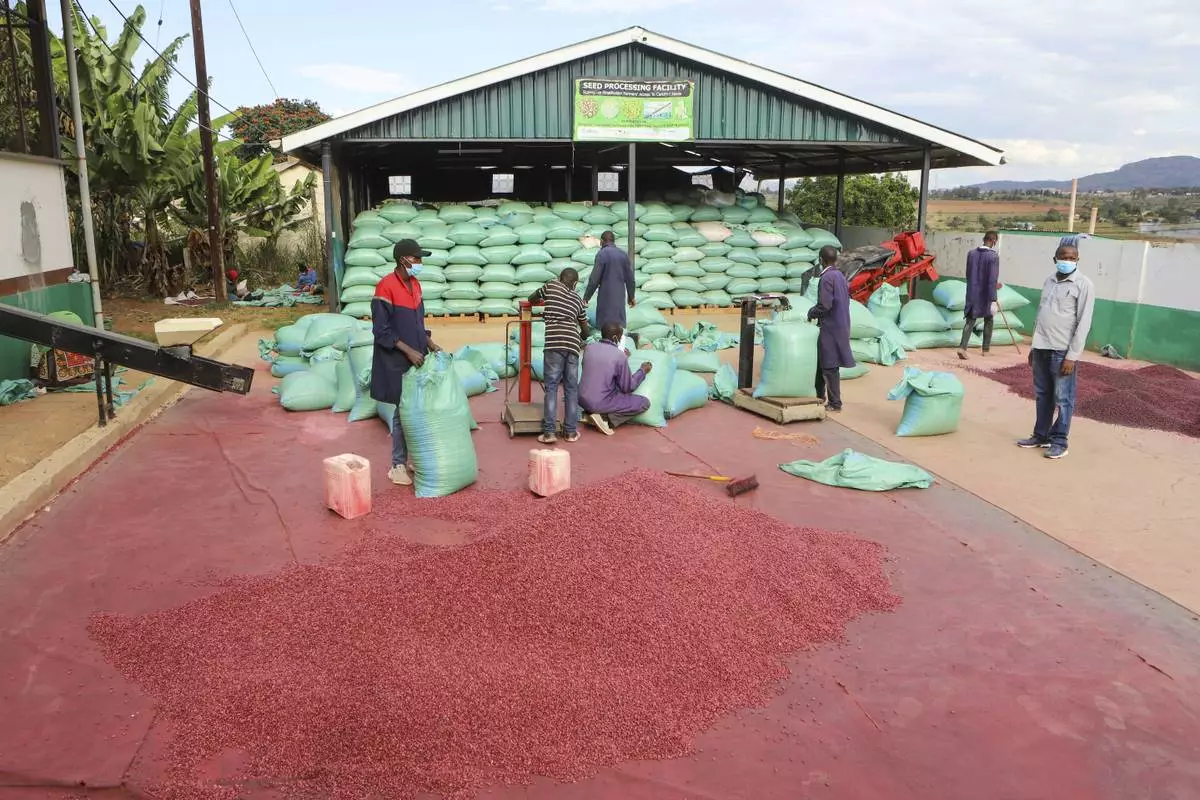
Farmers process climate-smart beans in Machakos, Kenya, Monday, March 18, 2024. From ancient fertilizer methods in Zimbabwe to new greenhouse technology in Somalia, farmers across the heavily agriculture-reliant African continent are looking both to the past and future to respond to climate change. (AP Photo/Andrew Kasuku)

Packed climate-smart beans are seen at a processing facility in Machakos, Kenya Monday, March 18, 2024. From ancient fertilizer methods in Zimbabwe to new greenhouse technology in Somalia, farmers across the heavily agriculture-reliant African continent are looking both to the past and future to respond to climate change. (AP Photo/Andrew Kasuku)

Farmers sort out climate-smart beans in Machakos, Kenya, Monday, March 18, 2024. From ancient fertilizer methods in Zimbabwe to new greenhouse technology in Somalia, farmers across the heavily agriculture-reliant African continent are looking both to the past and future to respond to climate change. (AP Photo/Andrew Kasuku)
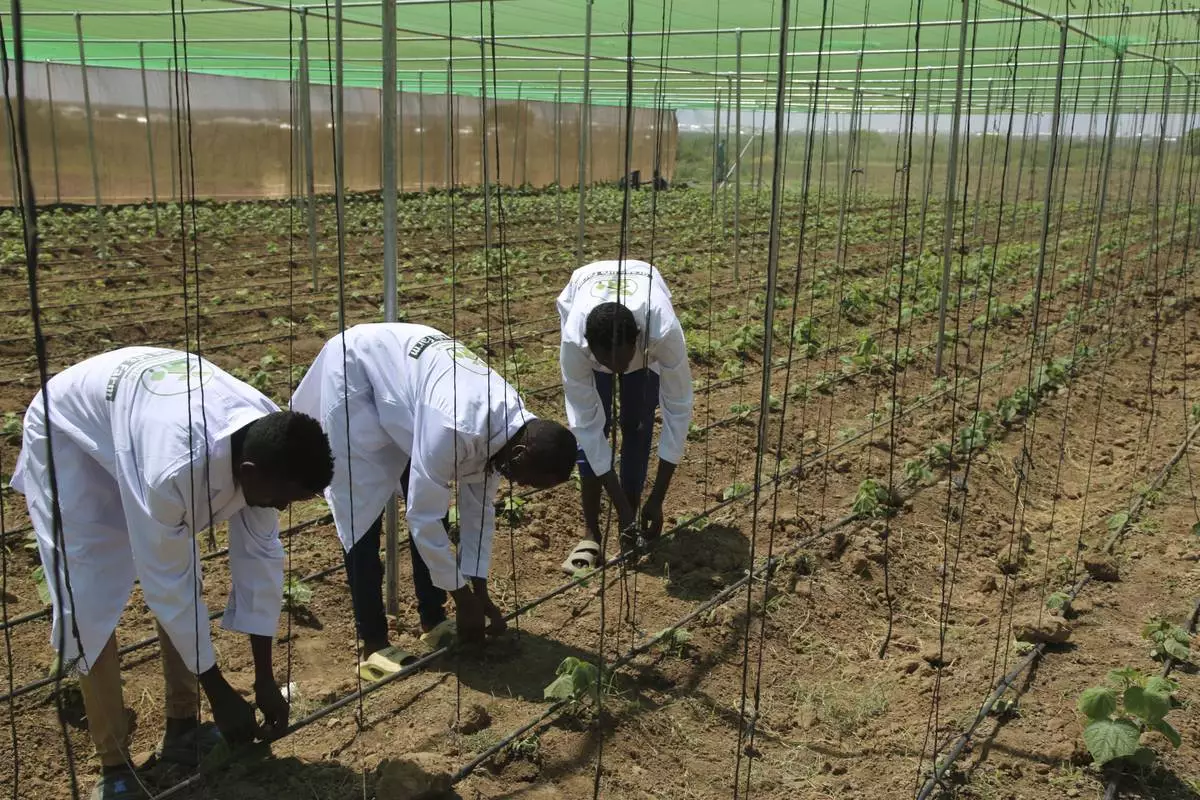
Workers check the growth of tomato seedlings at a greenhouse on the outskirts of Mogadishu, Somalia, Sunday, March 10, 2024. From ancient fertilizer methods in Zimbabwe to new greenhouse technology in Somalia, farmers across the heavily agriculture-reliant African continent are looking both to the past and future to respond to climate change. (AP Photo/Andrew Kasuku) (AP Photo/Farah Abdi Warsameh)

Plant pathologist Sila Nzioki sorts out dried climate-smart beans after checking them on a microscope at a plant pathology laboratory at the Kenya Agricultural and Livestock Research Organization (KALRO) Katumani Research Centre in Machakos, Kenya, Monday, March 18, 2024. From ancient fertilizer methods in Zimbabwe to new greenhouse technology in Somalia, farmers across the heavily agriculture-reliant African continent are looking both to the past and future to respond to climate change. (AP Photo/Andrew Kasuku)

Plant pathologist Sila Nzioki looks at dried climate-smart beans using a microscope at a plant pathology laboratory at the Kenya Agricultural and Livestock Research Organization (KALRO) Katumani Research Centre, in Machakos, Kenya Monday, March 18, 2024. From ancient fertilizer methods in Zimbabwe to new greenhouse technology in Somalia, farmers across the heavily agriculture-reliant African continent are looking both to the past and future to respond to climate change. (AP Photo/Andrew Kasuku)
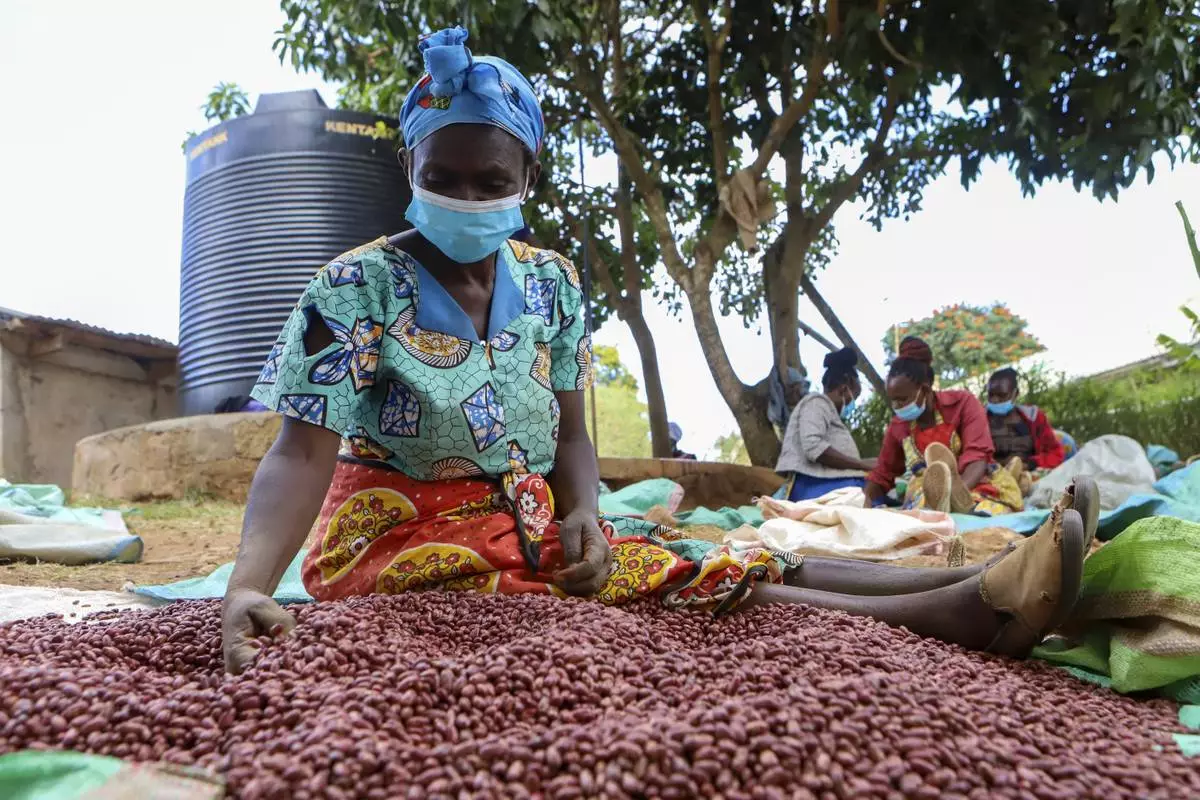
Farmers sort out climate-smart beans in Machakos, Kenya, Monday, March 18, 2024. From ancient fertilizer methods in Zimbabwe to new greenhouse technology in Somalia, farmers across the heavily agriculture-reliant African continent are looking both to the past and future to respond to climate change. (AP Photo/Andrew Kasuku)
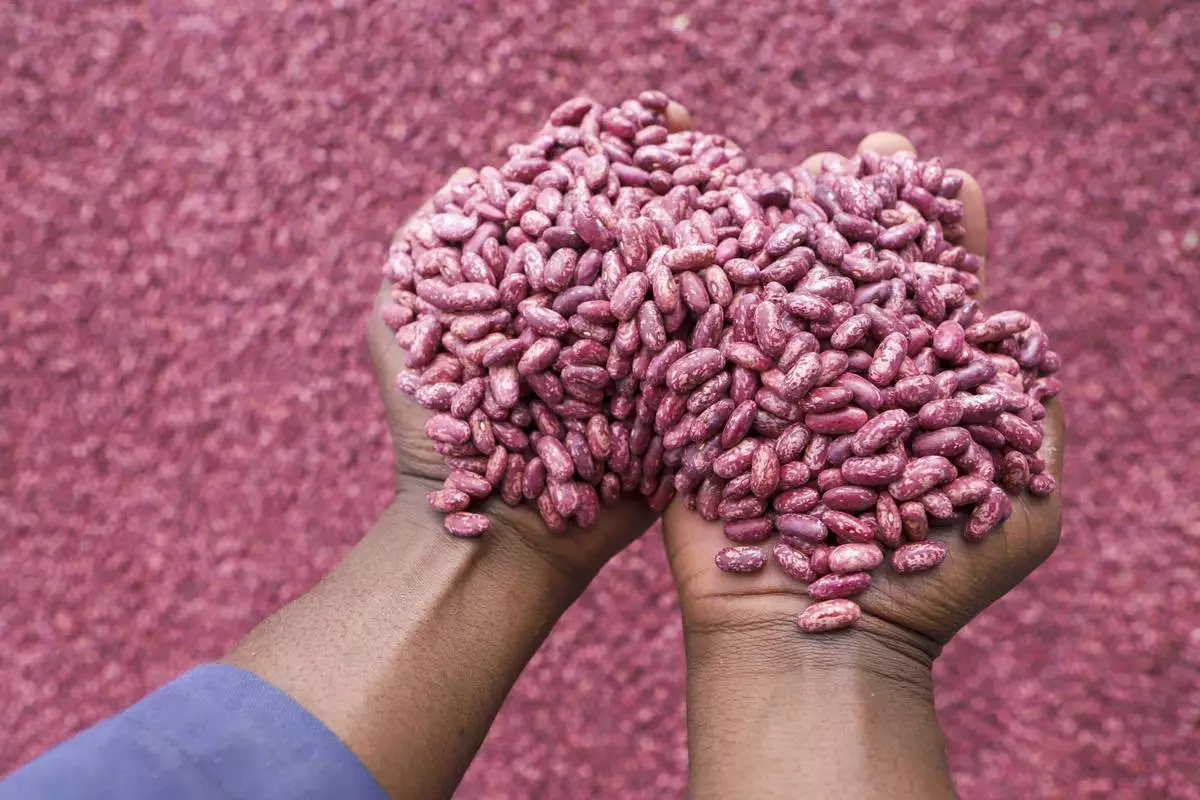
Farmers sort out climate-smart beans in Machakos, Kenya, Monday, March 18, 2024. From ancient fertilizer methods in Zimbabwe to new greenhouse technology in Somalia, farmers across the heavily agriculture-reliant African continent are looking both to the past and future to respond to climate change. (AP Photo/Andrew Kasuku)

James Tshuma, a small scale farmer, shows some of his vegetables he planted in a small garden at his home, in Mangwe district in Zimbabwe, on Friday, March 22, 2024. Tshuma has lost hope of harvesting anything from his fields. But a patch of green vegetables is thriving in a small garden the 65-year-old is keeping alive with homemade organic manure and fertilizer. (AP Photo/Tsvangirayi Mukwazhi)

James Tshuma, a small scale farmer, holds some of the plant residue he uses to take care of his garden in Mangwe district in Zimbabwe, Friday, March 22, 2024. Tshuma has lost hope of harvesting anything from his fields. But a patch of green vegetables is thriving in a small garden the 65-year-old is keeping alive with homemade organic manure and fertilizer. (AP Photo/Tsvangirayi Mukwazhi)
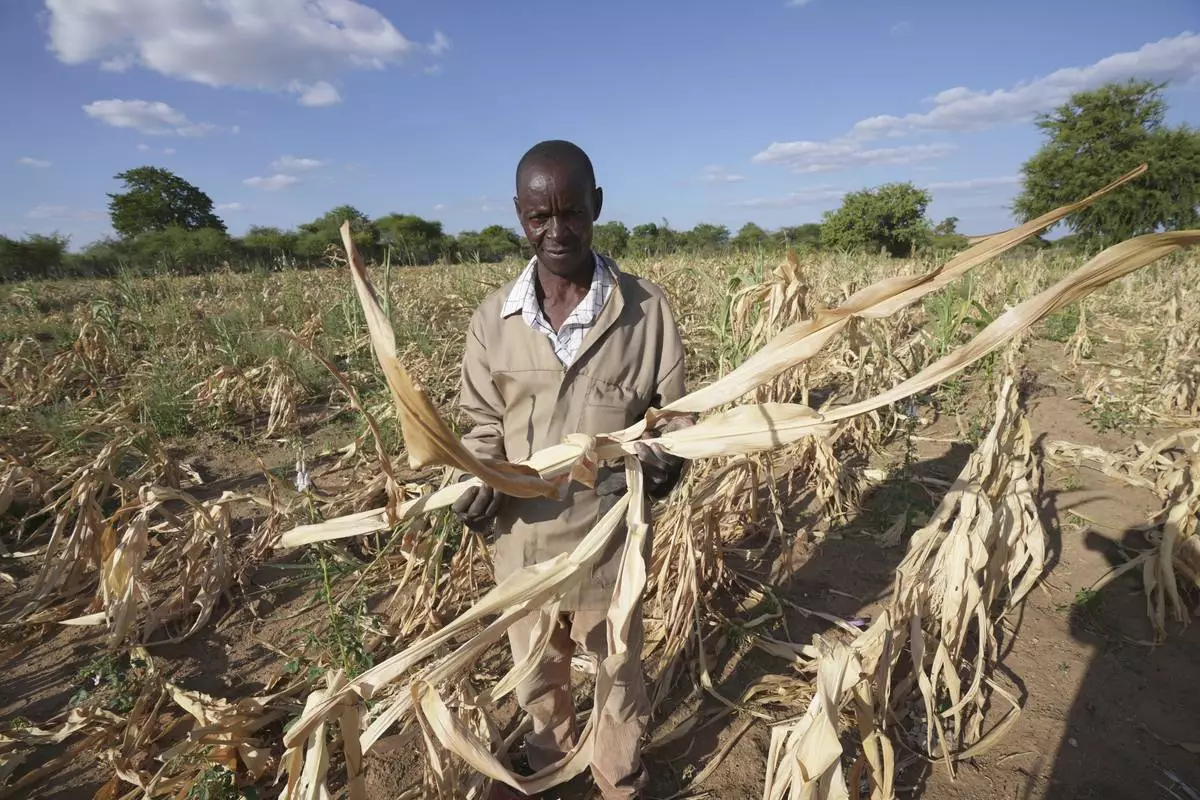
James Tshuma, a small scale farmer, holds a dried up maize crop in his field in Mangwe district, Zimbabwe, Friday, March 22, 2024. Tshuma has lost hope of harvesting anything from his fields. But a patch of green vegetables is thriving in a small garden the 65-year-old is keeping alive with homemade organic manure and fertilizer. (AP Photo/Tsvangirayi Mukwazhi)








